
The Golden Spike Ceremony and My Favorite Golden Spike Commemoratives
By: John Swindling
Imagine you are back in 1869, and you want to go across the country. Before the Transcontinental Railroad built by the Central Pacific and Union Pacific (UP) railroad companies, you would have had to ride on a horse or take a boat around the bottom of South America. These journeys would take several months, but after the tracks were completed, it took only about seven days! My favorite State Quarter has a picture of the Golden Spike Ceremony, which happened in Utah in 1869. This is the story of the trains, the golden spike, and the U.S. Mint’s coins and medals showing the event.
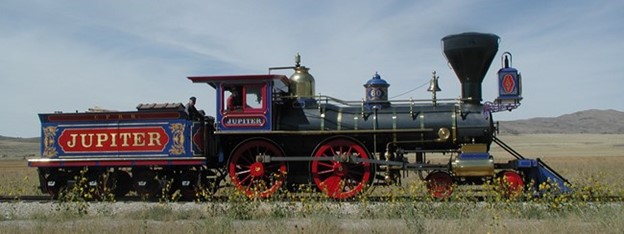
Most people know that Jupiter and No. 119 were the two engines at the ceremony, but did you know they weren’t supposed to be there? Originally, an engine named Antelope and an unknown Union Pacific engine were picked to attend the ceremony.
The Jupiter was part of a group of four engines, along with Storm, Whirlwind, and Leviathan built for Central Pacific in late 1868. Since there were no rails yet to California, the Jupiter was taken apart and put on a boat to go around South America. Six months later, it arrived and started working in California. Since the ceremony was scheduled in a few weeks, Central Pacific President Leland Stanford was choosing a special train. He picked #29, the Antelope. Their journey started with Jupiter leading the way to Promontory Summit carrying passengers, with Antelope trailing behind. While they were travelling, the Jupiter signaled to some construction workers that there was another locomotive following behind. However, the workers didn’t notice and cut down a tree which fell across the tracks. Not long after, Antelope came and hit the log! Nobody was injured, but Antelope was badly damaged. Antelope’s crew telegraphed the next station and told them to hold the Jupiter. When Antelope finally arrived at the station, Mr. Stanford’s special cars were coupled to Jupiter, which then took him to the ceremony.
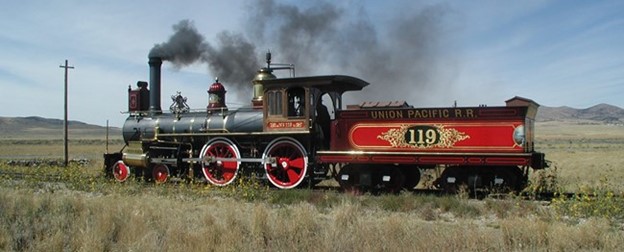
Union Pacific’s Vice President Thomas Durant chose a special locomotive and named the train the Durant Special. At the beginning of his travels, the Durant Special was held hostage by unpaid railroad tie cutters for two days! Then, on his way to Promontory Summit, a heavy rainstorm made a bridge they needed to cross very unstable. Durant’s crew had to telegraph the next station to get a new locomotive. UP engines numbered 116, 117, 118, 119 and 120 were all there, and No. 119 was the most ready to go. UP #119 picked up the passengers from the Durant Special and continued to the journey to Promontory Summit.
On May 9, 1869, the final tracks were completed. The official ceremony would take place the next day. To commemorate the special event, a friend of Mr. Stanford wanted to make a solid gold rail. Unfortunately, this was too expensive, so instead he used $400 of his own gold to create a special engraved golden railroad spike. That’s more than $8,000 in today’s money!
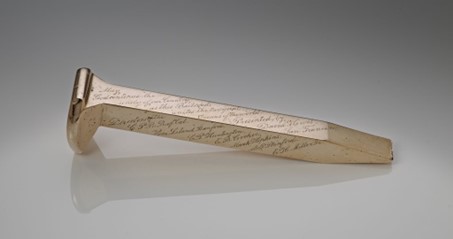
But did you know there was more than one special spike? There were actually three others! There was another gold one, a silver one, and one with gold and silver plating on a regular iron spike. They also used a special railroad tie made out of California Laurelwood, and a special silver-plated hammer. Captain John Currier, who was at the ceremony and wrote about it in his journal, watched as Mr. Stanford gently tapped the spike and the telegraph wire attached to it sent a message out. At 12:47 in the afternoon, the whole country got a message that said “D-O-N-E.” The Transcontinental Railroad was complete!
Soon after, the U.S. Mint struck a medal to commemorate finishing the Transcontinental Railroad. The front showed President Ulysses Grant with an inscription saying “The Oceans United By Railway” and the date of the Golden Spike Ceremony. The back showed a mountain scene with a steam engine and the words “Every Mountain Shall Be Made Low.” The medal was designed by William Barber and made in Philadelphia. Original 1869 medals are extremely rare today and can be very expensive if they are available.
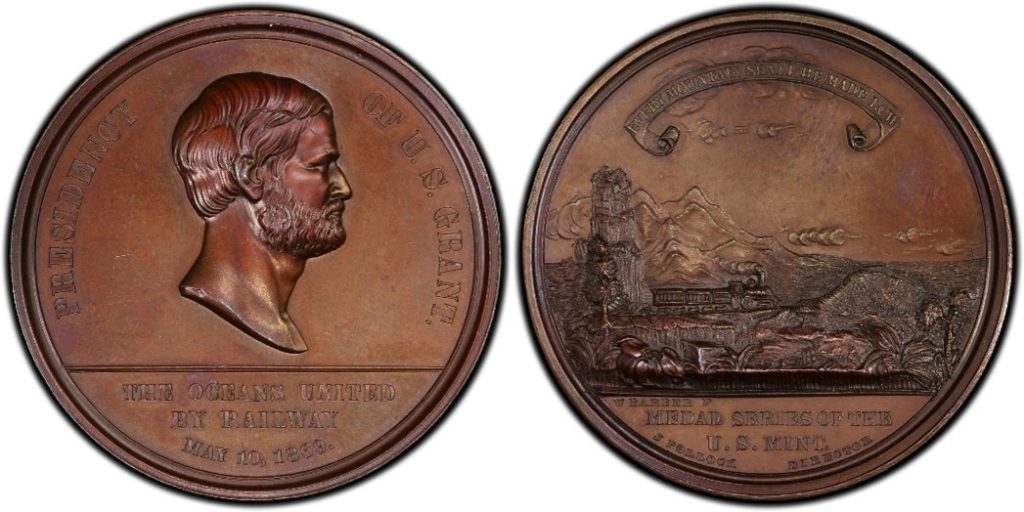
| Medal | Size | Mintage |
| Bronze | 45mm | 496 |
| Silver | 45mm | 126 |
| Gilt Bronze | 45mm (5.2mm Thick Planchet) | ??, only 2-4 known |
One hundred years later in 1969, there was another special medal made by the U.S. Mint in Philadelphia. On the front, it showed the Jupiter and UP #119 meeting at Promontory Summit. On the back, there was a picture of the Golden Spike and the years 1869-1969. The medal was engraved by Frank Gasparro and issued in bronze and silver. The Golden Spike Centennial Commission sold the medals for $2.50 to $25, depending on the one you wanted. Today, you can buy one of the small bronze medals for less than $50 if you want to add one to your collection!
| Medal Type | Size | Mintage | Issue Price |
| Small Bronze | 5/16″ (33.3mm) | 118,700 | $2.50 |
| Large Bronze | 2 1/2″ (63.5mm) | 4,750 | $7.50 |
| Large Silver | 2 1/2″ (63.5mm) | 3,000 | $25.00 |


In 2007, the Mint chose the design for the Utah State Quarter with a mountain background and with Jupiter and #119 facing a large Golden Spike in the middle. On November 9, 2007, the coins were released in a special event in Salt Lake City, Utah. This is my favorite State Quarter, and I have one in my collection!
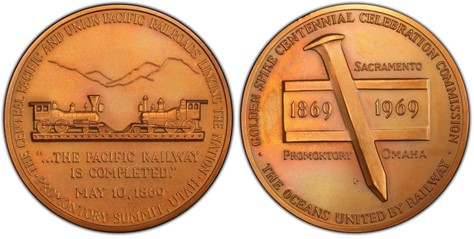
| Year | Type | Mintage |
| 2007-P | MS | 255,000,000 |
| 2007-D | MS | 253,200,000 |
| 2007-S | Proof | 2,374,778 |
| 2007-S | Silver Proof | 1,313,481 |
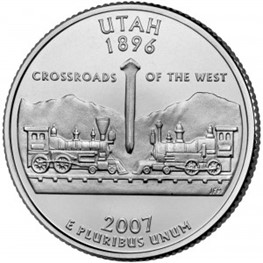
Today, you can visit operating replicas of Jupiter and #119 at the Golden Spike National Historic Park in Promontory, Utah. The park has a 15 mile stretch of rails from the original construction, and the site where the ceremony was held is close to the Visitor’s Center. The famous 1869 ceremony is commemorated with a plaque and a special polished railroad tie. They even do a reenactment of Andrew Russell’s famous photograph from the ceremony every year on May 10.
The Golden Spike is on display at Stanford University in California, along with a collection of items related to the Golden Spike ceremony. The university is named for the son of Leland Stanford, the man who rode the Jupiter back in 1869.
Finishing the Transcontinental Railroad was very important for traveling across the country. After the railroad was complete, it was much faster to go across the U.S. Nowadays, people use airplanes to travel. I would definitely rather travel on an Amtrak train, but would prefer a scenic American type steam train journey on the Transcontinental Railroad. I guess I’ll have to imagine it looking at my Utah state quarter!
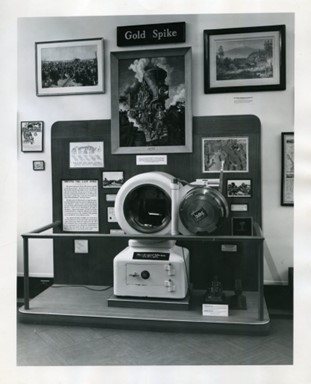
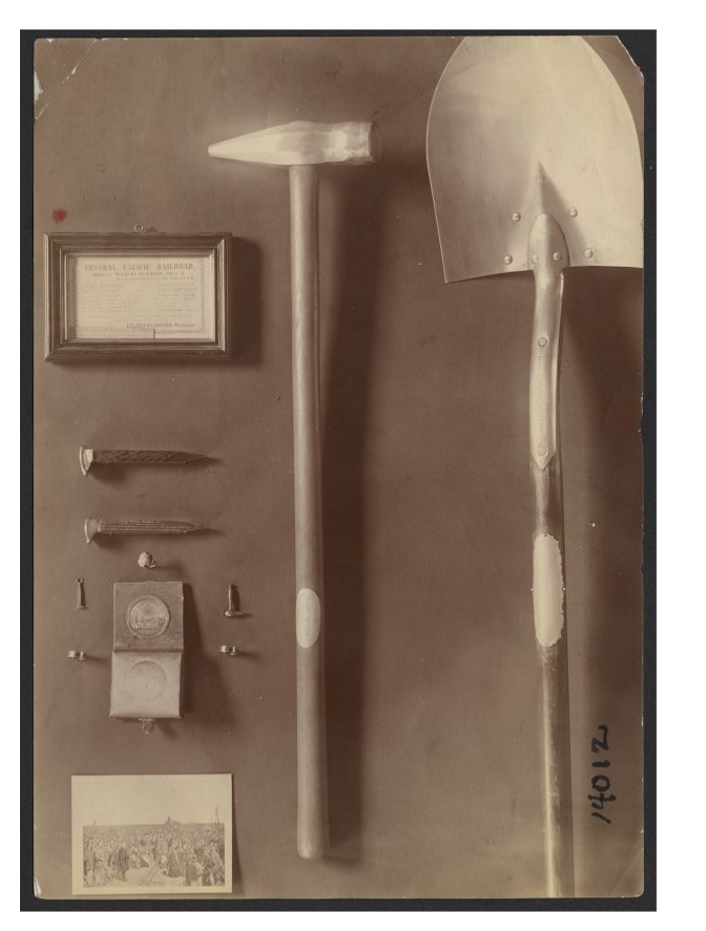
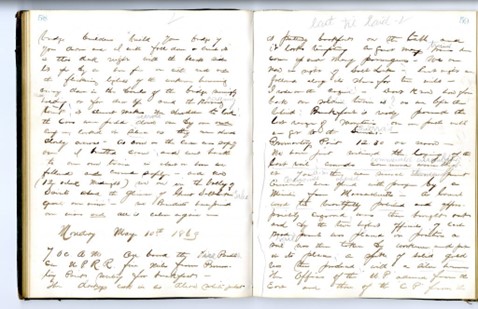
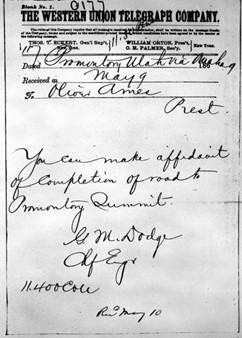
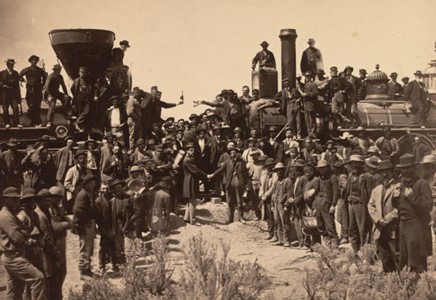
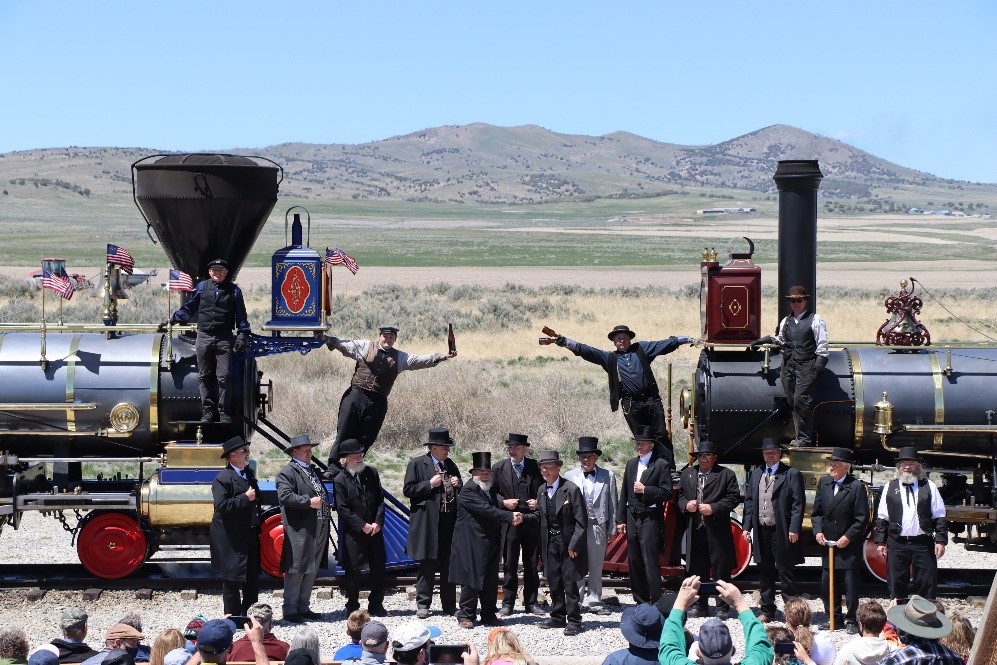
Sources:
- The Gilder Lehrman Institute of American History: https://www.gilderlehrman.org/sites/default/files/inline-pdfs/Transcontinental%20Railroad%20Fact%20Sheet.pdf
http://ap.gilderlehrman.org/resources/official-photograph-from-%C3%A2%E2%82%AC%C5%93golden-spike%C3%A2%E2%82%AC%C2%9D-ceremony-1869?period=6 - U.S. National Park Service, Golden Spike National Historical Park: https://www.nps.gov/gosp/learn/historyculture/everlasting-steam-the-story-of-jupiter-and-no-119.htm
https://www.nps.gov/gosp/learn/historyculture/four-special-spikes.htm - Union Pacific Locomotive #119 and Central Pacific Locomotive #60, Jupiter at Promontory Summit: https://irma.nps.gov/DataStore/DownloadFile/473119
- Union Pacific Heritage Archives, Rails Reach Promontory Summit: https://www.up.com/timeline/index.cfm/promontory-summit
- Inflation calculator: https://www.in2013dollars.com/us/inflation/1869?amount=400
- Wells Fargo Archives: https://www.wellsfargohistory.com/the-golden-spike-that-united-the-nation/
- Central Pacific Railroad Museum: http://cprr.org/Museum/Ephemera/Medallion_1969.html
- Mintage Figures and coin images: https://www.pcgs.com/coinfacts/coin/1969-p-medal-d1969-2a-matte-silver-63mm-golden-spike/76025
https://www.pcgs.com/coinfacts/coin/1969-p-medal-d1969-2c-bronze-golden-spike-small-rd/76031
https://www.pcgs.com/coinfacts/coin/1969-p-medal-d1969-2b-bronze-633m-golden-spike/76028
https://www.pcgs.com/coinfacts/coin/1869-sc-1-hk-12-bronze-pacific-railway-completion-bn/642035
https://www.so-calleddollars.com/Events/Pacific_Railway_Completion.html
https://www.usmint.gov/news/inside-the-mint/150-years-of-connecting-east-and-west-by-rail-and-numismatics - So-Called Dollars: An Illustrated Standard Catalog, by Hibler and Kappen. 2008 2nd edition.
- Stanford University Museum website: https://exhibits.stanford.edu/rr/catalog/xy521dg3472
https://exhibits.stanford.edu/rr/catalog/tm444gh5464

